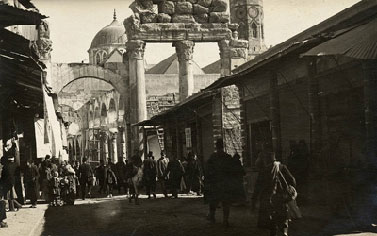
“Go back as far as you will into the vague past, there was always a Damascus. In the writings of every century for more than four thousand years, its name has been mentioned and its praises sung. To Damascus, years are only moments, decades are only flitting trifles of time. She measures time, not by days and months and years, but by the empires she has seen rise, and prosper and crumble to ruin. She is a type of immortality... Damascus has seen all that has ever occurred on earth, and still she lives. She has looked upon the dry bones of a thousand empires, and will see the tombs of a thousand more before she dies. Though another claims the name, old Damascus is by right the Eternal City.” -Mark Twain, The Innocents Abroad, 1869

Early History:
Rare are the countries that match the historic legacy of Syria. Damascus, the capital, is the oldest continually inhabited city in the world –a title purportedly rivaled chiefly by Aleppo, another Syrian city. To date, it is home to the first alphabet, first song, and first painting created by mankind. Recent archaeological findings trace the history of civilization in Syria back to the 10th millennium BC, thus, the oft-dubbed name “The Cradle of Civilization.”
It is believed that some of the earliest tribes that converted from hunting and gathering to agricultural settlements settled in the modern-day region of Syria around 9,000 BC. Later, the kingdoms of Ebla and Mari were established in the 3rd and 4th millennia BC. The 2nd and 3rd millennia BC witnessed the spread of the Hittites in Syria and the rise of Ugarit that was home to the first alphabet. The Phoenicians, Arameans, and Assyrians would later gain prominence on Syrian land with the latter empire spreading into Mesopotamia. By the 1st C. BC, the Hellenistic Empire would take hold of the region under Alexander the Great’s armies. This period saw the building of the city of Apamea, Lattakia, and Doura Europos. The Roman Empire would then take over and heighten its focus on Syria, which continued to prosper as a major trading hub. During this time, the city of Palmyra under the famous Queen Zenobia, grew in strength and seceded from the Roman Empire. The Palmyrene Empire stretched from northern Syria to Egypt and almost sacked Antioch until it was halted by the Roman armies. During the Roman era, 3 of the empire’s emperors were Syrian: Alexander Severus, Elagabalus, and Marcus Julius Philippus. The Roman Empire would then adopt Christianity and later become the Byzantine Empire, moving its capital to Constantinople.
Syria left an indelible mark on the history of Christianity for many reasons, chief of them being the conversion of Saul of Tarsus on the Road to Damascus to become Saint Paul. Saint Paul would then become the first missionary in Christianity, often called the “Father of Modern Christianity,” and would establish the first Christian church in Antioch. Syria would later become part of the Byzantine Empire until it is taken by the Muslims after the battle of Yarmuk (the master mind behind it, the legendary Khaled Ibn Al-Waleed, would choose the Syrian city of Homs as his burial place). Later, when the Umayyad dynasty took over the Muslim Empire, they chose Damascus as their capital. During that time, the Muslim Empire reaches the height of its power spanning three continents, Asia, Africa, and Europe. The Abbasid Dynasty would then take over, moving the capital to Baghdad. After a long period of power shifts between the Byzantines, Mamluks, Mongols (who destroyed much of Syria), Crusaders, Hamadanis, and others, the Ottoman Empire finally takes over Syria in the 16th C. and rules over it through World War I.
Modern History
With the conclusion of World War I and Syria gaining its independence from the Ottoman rule, the Syrian National Congress, headed by Hashim al-Atasi, crowns Faysal I as King of Syria in March 1920. In April 1920, the San Remo Conference puts Syria under French mandate against its will. In July, French troops enter Syria and are confronted at Maysaloun by the severely under-sized and under-equipped Syrian Army headed by the renowned Minister of War, Yousef Al-Azma. The French consequently defeat the Syrian army and Al-Azma heroically falls in battle. In August 1920, the French divide Syria and Lebanon, and in July 1932, the Republic of Syria is created with Mohammad Ali al-Abid as its first president. On April 17 1946, Syria gains its full independence after a long series of domestic uprisings and revolts, as well as robust diplomatic efforts led by the Syrian National Bloc. During the period between 1946 and 1970, Syria goes through an extended episode of political instability that brought numerous presidents, cabinets and parliaments.
In 1970, President Hafez Assad assumes power and brings much-needed stability to Syria. In his years in office, Syria goes through drastic transformations of industrialization, development, and military augmentation, catapulting Syria into a new dominant regional and international role. In those years, President Assad works tirelessly in an attempt to return the Golan, which was illegally occupied by Israel in 1967. Unfortunately, after several rounds of internationally- backed and US-brokered peace negotiations, Israel explicitly proves its unwillingness to abide by international law and free the land and people it occupies. In July 2000, President Bashar Assad takes office and maintains Syria’s policy that aims for a peaceful conclusion of the Arab-Israeli conflict, returning all occupied Arab territories and ending Israeli occupation. He also leads a major transformation of the Syrian economy based on social market principles, liberalizing the economy while simultaneously creating a social safety net. During his presidency, Syria reaches an unprecedented 6.1% economic growth rate, while a vigorous foreign policy maintains Syria’s positive role in the region and helps position it as a dynamic geopolitical hub between the different regions and actors.
Syrian Culture:
Syria has served as a major crossroads in the Middle East since prehistoric times, leaving it open to change and passing customs. The country’s melting pot of societies, as a result of its history, has led it to become one of the most ethnically diverse areas in the world, filled with a unique and flourishing culture. Today, Syria is witnessing a forward projectile dynamic of cultural life, intertwining a rich cultural heritage with a vibrant and promising modern movement.
Damascus, Cultural Capital
As the oldest inhabited city in the world, Damascus was named the 2008 Arab Capital of Culture by the United Nations Educational, Scientific and Cultural Organization. A series of festivals and celebrations took place throughout the year, including special musical performances, literary recitations, and dance recitals. For a list of the events, please click here. President of Syria, Bashar Al Assad, commented January 18, 2008 during the festival’s opening ceremony, “Damascus, Arab Capital of Culture, embodies a living example of the dialogue and coexistence of cultures; it represents a symbol of diversity within unity and an attribute of the beauty of the rainbow of human life. Through all this, Damascus provides definite proof that the notion of the conflict of civilizations is both null and void."
Cuisine
Syrian cuisine has long been renowned for its use of aromatic spices, vegetables, nuts, and grains, each specifically bended into an assortment of flavorful and nutritious dishes. The addition of lemon, onion, mint, and parsley as well as garlic is additionally utilized in vast quantities to accompany strong flavoring. A typical Syrian meal begins with the spread of various salads and hor d’oeurves including Tabouli, Fattoush, Hummus, and Baba Ghanoush. The main meal of the day, consumed early within the afternoon, often includes a meat dish, of typically chicken or beef, accompanied with seasoned vegetables and rice. Each meal is then followed by tea or coffee, platters of fruit, and sweetened pastries. Click here for traditional Syrian recipes.
Literature
While Syrian literature dates back hundreds of years, it most flourished during the late nineteenth century where aspiring Syrian writers contributed immensely to the literary and cultural renaissance of the Arab world. Prominent contemporary writers include Muhammad Maghout, also known as the father of Arabic free verse poetry, who revolutionized the traditional structures of poetry and playwriting and was an avid contributor to Syrian theater, television, and cinema. Ghada al-Samman, a novelist and journalist, is of the pioneers for women writers in Damascus. She continues to write short stories and novellas ranging in topic from romance to politics to the characteristics of the human persona. Perhaps one of the most renowned and well respected poets within the Arab world, Nizar Qabbani discussed issues of Arab nationalism, love, feminism, and religion within his simplistic style of writing. While predominantly a poet, Qabbani additionally wrote several works of prose and composed the lyrics for many revered Arab singers.










